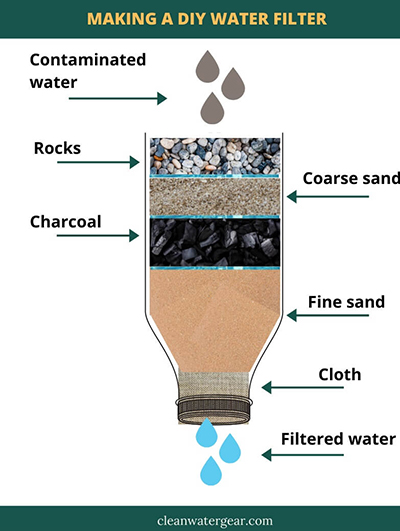
Melondy Phillips
Staff Writer
• Learn some “old time” skills, such as how to start a fire with flint and steel. Once this skill is learned, it is more reliable than a box of matches and lasts longer than a lighter. I can say, from experience, that this technique can be used to light a candle. There are also many other ways to start fires for cooking food, or providing light. Learn more.
• Think about how you could bathe yourself without any power and have a plan for it. Being clean is as good for the mind as it is for the body. And be honest, having a way to bathe yourself can also help improve the morale of those around you.
• Learn how to make a homemade water filter. One way to is to first find a bucket (needs a small hole in the bottom), 2-liter bottle (cut off the bottom, turn it upside down, and poke a hole in the lid), or any decent container that can hold solids but let liquids through small holes in the bottom. In the bottom of the container, place something fine such as cotton balls, a clean piece of cloth, or fine sand. The next layer should be charcoal which can be obtained from a fire pit if there is no activated charcoal available. Do NOT use charcoal briquettes from a grill; these have chemicals in them. Next add a layer of sand or dirt, then grass or straw, cover with a layer of small rocks, and finally a layer of larger rocks. The idea is to force the water through finer and finer material to remove as many impurities as possible. I like to add a layer of cloth, as a pre-filter, over the top. This pre-filter prevents leaves and other large items from clogging the homemade filter and can be switched out as needed. The water should be added slow-ly so that it can take its time filtering through the multiple layers.
Pouring water through it too quickly may not allow it to filter as well. Once the water is filtered, bring it to a full boil for at least 10-15 minutes before consuming it. Remember, animals need water too but their digestive systems can usually handle non-boiled water – you know your pets, be smart.
• Ways to use the bathroom: Let’s face it, it’s going to happen. Having a safe and sanitary way to go is important to a person’s health. If the house toilet is still functional but there isn’t power to draw water, keeping a bucket full of water beside the toilet is one simple fix. This can be easily refilled if there is a stream or other body of water nearby. If you anticipate a power outage, having the bathtub filled with water may provide several days’ worth of flushes if you are frugal. There are still many homesteads near us that have functioning outhouses in use.
Don’t be put off by outhouses and maybe think about installing one on your property, if possible; they are a welcome sight when the need arises.
• Make an emergency grab bag tool bag – no electric or batteries needed,. Some items to consider for this are: a small hand shovel, tarp (in case a window gets broken or there is hole in the roof), rope, hand saw or rope saw, screw driver, knife, electrical and duct tape, hand drill, hammer, oil, tire repair kit, small air compressor (for cigarette lighter port in car), etc.
• Always carry a winter bag/essential kit in your car. This should contain warm, dry clothes and socks, an emergency blanket, balaclava (face covering), warm, water proof boots, candle, matches, a piece of foil, bottle of water, energy snack bar, basic first aid items, a few days’ worth of medication, and a wash cloth. Within this pack there should be a smaller sub-pack, or necessities kit, that attaches to a belt and contains everything you need to survive several days if you must leave your car and start walking. I may cover this type of thing in a future article. When properly packed, all items should not take up more than about 1.5 square foot of space (two at the most) but will be extremely helpful if a situation presents itself.



